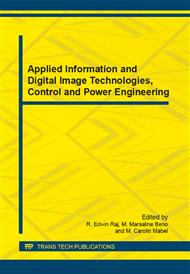[1]
Kondili E , Kaldellis JK. Environmental-Social Benefits/Impacts of Wind Power. Comprehensive Renewable Energy 2012; vol. 2: pp.503-539.
DOI: 10.1016/b978-0-08-087872-0.00219-5
Google Scholar
[2]
Kaldellis JK, Kapsali M, Kaldelli EI, Katsanou EV. Comparing recent views of public attitude on wind energy, photovoltaic and small hydro applications Renewable Energy. 2013; vol. 52: pp.197-208.
DOI: 10.1016/j.renene.2012.10.045
Google Scholar
[3]
Chaturvedi R, Murthy SS. Use of conventional induction motor as a wind driven self excited induction generator for autonomous operation. IEEE Transactions on Energy Conversion Apr. 1989; vol. 45: p.2051-(2055).
DOI: 10.1109/iecec.1989.74755
Google Scholar
[4]
Nishad Mendis, Kashem M. Muttaqi, and Sarath Perera. Standalone Operation of Wind Turbine-Based Variable Speed Generators With Maximum power Extraction Capability . IEEE trans. energy conversion 2012; 27: 822-834.
DOI: 10.1109/tec.2012.2206594
Google Scholar
[5]
Chaturvedi R, Murthy SS. Use of conventional induction motor as a wind driven self excited induction generator for autonomous operation. IEEE Transactions on Energy Conversion 1989; vol. 35: p.2051-(2055).
DOI: 10.1109/iecec.1989.74755
Google Scholar
[6]
Poddar G, Joseph A, Unnikrishnan A. Sensorless variable-speed controller for existing fixed-speed wind power generator with unity power-factor operation. IEEE Transactions on Industrial Electronics 2003; vol. 50: pp.1007-1015.
DOI: 10.1109/tie.2003.817689
Google Scholar
[7]
Kim HG, Lee DC, Seok JK, Lee GM. Stand-alone wind power generation system using vector-controlled cage-type induction generators. Proceedings of the ICEMS Conference 2003; pp.289-292.
Google Scholar
[8]
Pena R, Cardenas R, Blasco R, Asher G, Clare J. A cage induction generator using back to back PWM converters for variable speed grid connected wind energy system. Proceedings of the IEEE-IECON 2001; pp.1376-81.
DOI: 10.1109/iecon.2001.975982
Google Scholar
[9]
Simoes MG, Bose K. Fuzzy logic based intelligent control of a variable speed cage machine wind generation system. IEEE Transactions on Power Electronics Jan. 1997; vol. 12: pp.87-95.
DOI: 10.1109/63.554173
Google Scholar
[10]
Shimy MEI. Probable Power Production In Optimally Matched Wind Turbine Generators. Sustainable Energy Technologies And Assessments 2013; 2: 55-66.
DOI: 10.1016/j.seta.2013.03.002
Google Scholar
[11]
Zidani Y, Naciri M. Dynamic study of the induction machine supplied by a self excited induction generator. In: International Conference on Signals Systems. Decision and Information Technology (SSD 2003), Tunis, March 26-28 (2003).
Google Scholar
[12]
Murthy SS, Singh BP, Nagamani C, Satyanarayana KVV. Studies on the use of conventional induction motor as self excited induction generators. IEEE Transactions on Energy Conversion. 1988 ; 13 : 842-848.
DOI: 10.1109/60.9360
Google Scholar
[13]
Jang JSR, Sun CT, Mizutani E. Neuro-fuzzy and Soft Computing: A Computational Approach to Learning and Machine Intelligence, New Jersey, Prentice-Hall, (1997).
Google Scholar
[14]
Culliere T, Titli A, Corrieu J. Neuro-fuzzy modeling of nonlinear systems for control. In: . IEEE Int. Conf. On Fuzzy Systems, Yokohama, pp.2009-2016, (1995).
DOI: 10.1109/fuzzy.1995.409954
Google Scholar
[15]
Zouggar S, Zidani Y, ELhafyani ML, Ouchbel T, Seddik M. Neural Control of the Self-Excited Induction Generator for Variable-Speed Wind Turbine Generation, Smart Innovation, Systems and Technologies springer. 2013; vol. 12: pp.213-22.
DOI: 10.1007/978-3-642-27509-8_17
Google Scholar


